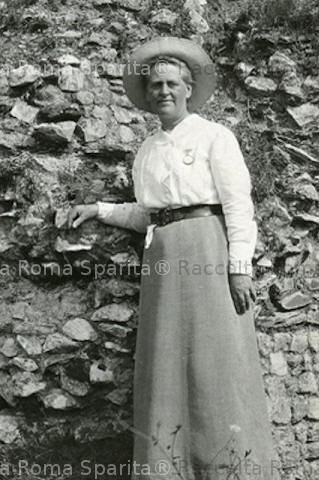

Queer Places:
University of Michigan, 1230 Murfin Ave, Ann Arbor, MI 48109
Wellesley College (Seven Sisters), 106 Central St, Wellesley, MA 02481
Bryn Mawr School, 109 W Melrose Ave, Baltimore, MD 21210
University of Chicago, 5801 S Ellis Ave, Chicago, IL 60637
Mount Holyoke College (Seven Sisters), 50 College St, South Hadley, MA 01075
Goucher College, 1021 Dulaney Valley Rd, Baltimore, MD 21204
Campo Cestio, Via Caio Cestio, 6, 00153 Roma, Italy
 Esther
Boise Van Deman (October 1, 1862 – 3 May 1937) was a leading archaeologist of
the late 19th and early 20th centuries.
Esther
Boise Van Deman (October 1, 1862 – 3 May 1937) was a leading archaeologist of
the late 19th and early 20th centuries.
Van Deman was born in South Salem, Ohio, to Joseph Van Deman and his second wife, Martha Millspaugh. She was the youngest of six children, including two boys by her father's first marriage.[1]
She earned an A.B. (1891) and A.M. (1892) from the University of Michigan in Ann Arbor. After teaching Latin at Wellesley College and the Bryn Mawr School in Baltimore, Maryland, she received a Ph.D. from the University of Chicago in 1898. She then taught Latin at Mount Holyoke College (1898–1901) and Latin and classical archaeology at Goucher College (1903–06). From 1906 to 1910 she lived in Rome as a Carnegie Institution fellow, and from 1910 to 1925 she was an associate of the Carnegie Institution in Washington, D.C. Between 1925 and 1930 she taught Roman archaeology at the University of Michigan.
Her life's work centered around the analysis of building materials to establish a chronology of construction on ancient sites. In 1907, while attending a lecture in the Atrium Vestae in Rome, Van Deman noticed that the bricks blocking up a doorway differed from those of the structure itself and showed that such differences in building materials provided a key to the chronology of ancient structures. The Carnegie Institution published her preliminary findings in The Atrium Vestae (1909).[2] Van Deman extended her research to other kinds of concrete and brick construction and published "Methods of Determining the Date of Roman Concrete Monuments" in The American Journal of Archaeology.[3] Her basic methodology, with few modifications, became standard procedure in Roman archaeology. Van Deman's major work, written after she retired and settled in Rome, was The Building of the Roman Aqueducts (1934).[4] She died in Rome, Italy, on May 3, 1937. She is buried in the Protestant Cemetery in Rome, near the Porta Ostiense. At the time of her death, Van Deman was at work on a monograph-length study of Roman construction. Her work was completed and published by Marion Elizabeth Blake (1882–1961).[5]
Van Deman's nephew, Ralph Van Deman Magoffin (1874–1942), published a study of the Italian city of Praeneste.[6]
My published books:
https://en.wikipedia.org/wiki/Esther_Boise_Van_Deman